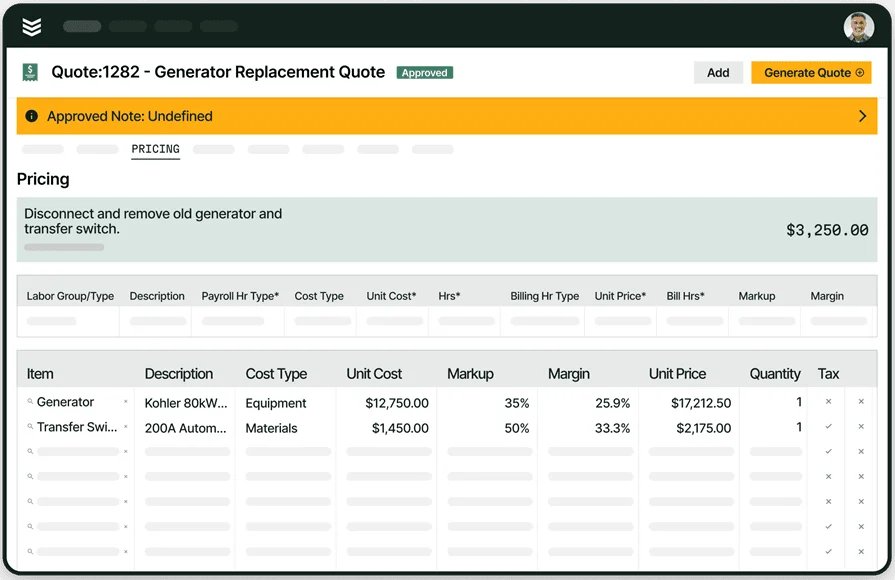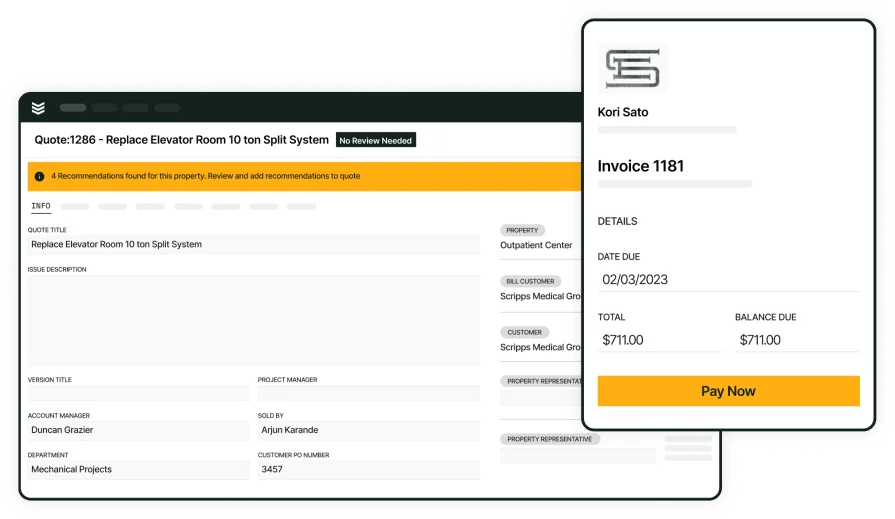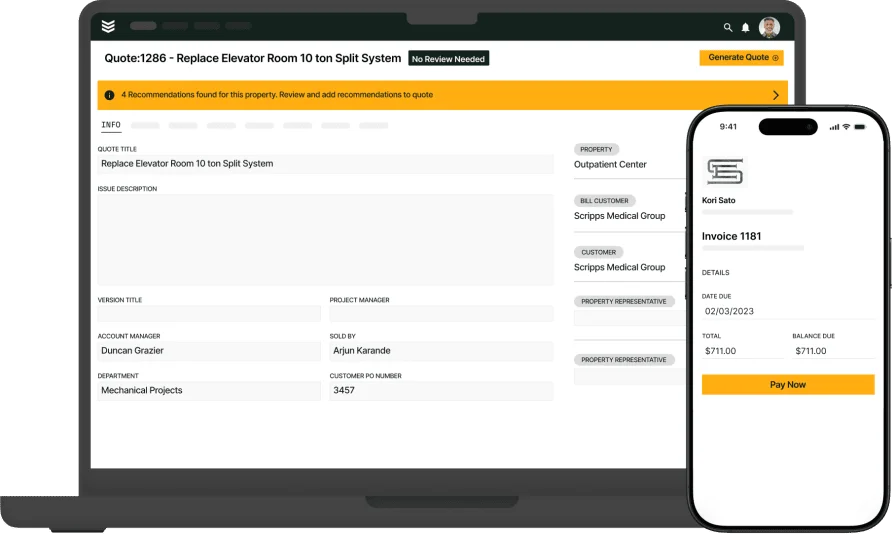When a bid goes sideways, it’s rarely a surprise. A missed line item. A rushed labor rate. A markup that didn’t cover real costs. That’s how profits disappear.
Electrician estimating software puts you back in control. It builds quotes that reflect the actual work—down to wire counts, labor shifts, and gear setups. No back-and-forth between paper, spreadsheets, and guesswork. Just one place to price every part of the job.
For those in the electrical industry, having the right software means quotes stay sharp, accurate, and tied directly into job details—from the first walkthrough to the final invoice. Here’s what we’re covering in this guide:
- Choosing the best electrician estimating software for your workflow
- 6 key features electricians should look for in estimating software
- 7 top electrician estimating software platforms
- 7 benefits of using electrician estimator software
- 5 important electrician estimating software FAQs answered
A strong estimate sets the tone for everything that follows. Before digging into features and platforms, let’s start with what electricians need to watch for when evaluating tools built for the field.
Choosing the best electrician estimating software for your workflow
For electricians handling service work, estimating tools need to work hard and fast. You’re quoting on the fly, dealing with real jobsite conditions, and every number on that estimate matters. Before committing to any electrician estimating software, make sure it checks the boxes below.
- Ease of use – Can techs create estimates without getting slowed down? Is the interface simple enough to handle during a full day of service calls? Can the office turn around quotes without digging through menus?
- Labor and pricing control – Can you fine-tune labor rates based on role or task? Does it reflect supplier price shifts without manual entry? Can markups and overrides be handled in the field?
- Workflow compatibility – Does the software align with how your team builds and approves quotes? Can approved estimates trigger job tickets or follow-ups? Are edits possible when scope changes mid-call?
- Mobile and field-ready – Does it work on-site with tablets and phones? Can techs quote while on location? Is offline functionality available when connections drop?
- Features – Are templates built for the kind of jobs your team does? Can it generate branded proposals with auto-filled totals? Does it offer reporting on estimate wins and job margins?
Electrician estimator software should work the way your field crew already does—quick, flexible, and built for fast approvals. Up next: six features that help estimating tools deliver under pressure.
6 key features electricians should look for in estimating software
Service electricians work fast, often quoting jobs in real time while handling client questions, travel, and last-minute changes. With so many moving parts, the electrician estimating software you use needs to keep pace. Estimating isn’t just about numbers—it’s about syncing with the tools, data, and job details your crew depends on. These six features make the difference between a slow quoting process and one that keeps work moving forward without delays.
1. Field service scheduling and dispatch
When estimating ties directly into your field service scheduling and dispatch workflow, it saves time and prevents miscommunication. Once a quote is approved, your software should be able to move that estimate straight into the schedule—no extra steps, no double entry.
Let’s say you quoted a tenant improvement job downtown, and the client gives you the green light before lunch. Without leaving the platform, that approved estimate triggers a crew assignment and dispatch notice, all while you're still on-site. No paperwork trail. Just work that gets booked, assigned, and executed fast.
2. Mobile estimating capabilities
For estimating to stay accurate, it needs to happen at the job site. With mobile access, electricians can build estimates directly from the field—pulling labor, parts, and notes into the quote while the details are still fresh. Say your tech just opened a panel and spotted outdated gear behind the wall. Instead of waiting to call it in, they pull up the software, add the gear replacement line item, adjust the labor, and send the quote for review—without heading back to the truck.
3. Integrated time tracking
With time tracking baked into your estimating software, you can quote based on actual labor data. That means smarter estimates that reflect how long tasks really take—not just flat averages or best guesses. Think about quoting an emergency lighting system replacement. Your past jobs show how long your crew took to complete similar work. You pull those numbers into the estimate and avoid the guesswork—helping you protect the job’s margin from the start.
4. Invoice-ready estimates
A strong estimate sets up the billing cycle. When electrician estimating software includes invoice generation, it makes sure every approved quote becomes a bill without skipped steps or missing charges. After wrapping up a subpanel replacement, your estimate already contains the breakdown. Your invoicing tool pulls labor, parts, and hours directly from the quote and generates a professional invoice—ready to send before you leave the site.
5. Real-time cost tracking and reporting
Accurate estimates rely on visibility. With real-time reporting tools, you can compare your estimates to actual job costs and spot issues before they hit your bottom line. Take a project where costs begin to shift mid-install—copper prices jump, or overtime hours climb. Your software shows the variance between the original estimate and the current total in real time, giving you a chance to fix it before the margin disappears.
6. Built-in payment tools
The faster a quote becomes an invoice—and the faster that invoice gets paid—the healthier your cash flow. With payment processing built in, electrician estimator software helps you move from field to payment without extra tools. For instance, you finish a generator hookup on Friday afternoon. Before leaving, you send the client the estimate-turned-invoice with a link to pay by card. No checks. No delays. Just a clean handoff from service to payment that keeps things moving.

Improve electrical estimating
Provide accurate estimates that land you jobs and get you paid faster.
Other notable features electrician estimating software
While these features may not drive your core estimating process, they add serious value when built into your software. For service electricians managing ongoing client relationships or larger project pipelines, these extras help tighten up operations and boost visibility across the board.
- Customer and job history visibility – With an integrated CRM system, your estimating tool stores service history, contacts, notes, and past quotes. This helps your team quote based on real context—avoiding repeated work or missed opportunities on return visits.
- Service agreement tracking – Built-in service agreement tools help manage recurring contracts, scheduled inspections, and agreement-based pricing. This supports better long-term client management directly from your estimating workflow.
- Project pipeline visibility – Estimating software with pipeline tracking gives visibility into open quotes, pending approvals, and active bids. It helps prioritize which estimates to follow up on and where your close rates stand over time.
These additions don’t replace core estimating tools, but when they’re part of the platform, they give your team deeper control and insight across service projects.
7 top electrician estimating software platforms
Electricians rely on estimating tools that don’t just calculate costs—they support the way field and office teams actually work. Whether you're handling service upgrades, tenant fit-outs, or long-term commercial installs, the best electrician estimating software fits the size, speed, and scope of your jobs. Below, we break down seven trusted platforms, each with different strengths depending on team structure, project type, and how deeply you need features tied into the rest of your operations.
1. Best for commercial electricians: BuildOps
BuildOps gives electrical contractors a platform designed specifically for large-scale commercial service work. It connects field estimating with scheduling, invoicing, and reporting—everything tied into one system. Electricians can quote complex installs, manage revisions, and push approved estimates straight into the job pipeline without manual steps. Real-time cost tracking and prebuilt takeoff tools help field teams move quickly without losing visibility.
How pricing works: BuildOps builds pricing around your business size and scope—so you only pay for features that drive your service and estimating process forward.
Features beyond estimating:
- Field service scheduling and technician dispatch
- Mobile app for field quoting, notes, and job tracking
- Invoicing, payments, and service agreement management
What sets it apart for commercial electricians: BuildOps supports end-to-end estimating for electricians tackling tenant improvements, system upgrades, and fast-turn service jobs. With every tool connected, it removes the delays between quoting and job execution.

Explore our estimating product
We help electricians quote jobs reliably so you get paid faster.
2. Best for residential electricians: PlanSwift
Image Source: PlanSwift
PlanSwift offers a takeoff-focused estimating tool built for residential electrical jobs. Contractors can drag and drop material and labor assemblies, use digital plans for counts, and speed up bid creation on small-to-midsize home projects. Its strength lies in its visual takeoff interface, which helps smaller teams reduce manual entry while estimating common home installations. While effective for single-property quoting, PlanSwift may not be the ideal choice for contractors needing field-to-office syncing, dispatch integration, or invoice automation.
How pricing works: PlanSwift charges a flat license fee with optional annual updates and support add-ons.
Features beyond estimating:
- Visual plan takeoffs and material counts
- Integration with Excel-based templates
- Drag-and-drop tools for building assemblies
What sets it apart for residential electricians: PlanSwift simplifies takeoffs and speeds up quoting for electricians handling high volumes of service work and residential installs.
3. Best for general contractors: McCormick Systems
Image Source: McCormick
McCormick Systems delivers robust estimating software for general contractors with electrical divisions. It supports database-driven item libraries, detailed assemblies, and multi-phase bid creation. Contractors handling industrial or multi-trade projects benefit from its flexibility and depth of cost tracking. Due to its complexity, McCormick may not be the best fit for service electricians needing mobile access, quick quote generation, or tight integration with dispatch and field operations.
How pricing works: McCormick offers tiered packages depending on team size and software depth—ranging from single-user tools to enterprise-level solutions.
Features beyond estimating:
- Project scheduling and job cost tracking
- Integration with third-party accounting systems
- Scalable from small shops to enterprise estimating setups
What sets it apart for general contractors: McCormick gives larger firms control over high-detail estimates, but often suits teams with dedicated estimating staff over field techs.
4. Best for small teams needing flexibility: FreshBooks
Image Source: FreshBooks
FreshBooks is a cloud-based tool built with simplicity in mind, offering fast estimate creation for small service contractors. Electricians can build and send quotes, convert them into invoices, and track payments—all from a clean, mobile-friendly dashboard. It’s especially useful for solo operators or lean teams that want minimal setup and easy-to-use tools. That said, FreshBooks may not be the ideal choice for contractors looking for deep job costing, crew scheduling, or dispatch capabilities tied into their estimating.
How pricing works: Subscription plans are based on feature access and client limits, with monthly and annual options.
Features beyond estimating:
- Invoicing and online payment collection
- Time tracking and basic project management
- Client communication and recurring billing
What sets it apart for small teams: FreshBooks gives small electrical businesses a simple toolset to quote, bill, and track work without heavy overhead or complexity.
5. Best for digital takeoffs: STACK
Image Source: STACK
STACK provides estimating and takeoff software designed for contractors working with digital plans. It allows electricians to upload drawings, measure directly on-screen, and pull quantities into detailed estimates. Its cloud-based interface makes it easy to collaborate across office and field teams reviewing plans together.
STACK may not be the best choice for service-focused electricians who rely on mobile job tracking, quick on-site edits, or dispatch integration.
How pricing works: Plans are offered based on number of users and feature tiers, with free trials available for evaluation.
Features beyond estimating:
- Plan management and document sharing
- Team collaboration on takeoffs and markups
- Customizable material catalogs and assemblies
What sets it apart for takeoffs: STACK helps electrical contractors digitize their takeoff process, especially useful when quoting off full construction sets.
6. Best for template-driven estimating: Countfire
Image Source: Countfire
Countfire focuses on automation-first estimating, helping electricians build consistent, fast quotes from templates and historical data. It’s designed to cut repetitive entry by letting users copy common project types and standard assemblies across estimates. Teams can save commonly quoted job packages and reuse them to speed up future bids. This may not be the ideal platform for service electricians who need live job sync, real-time material tracking, or built-in scheduling tools.
How pricing works: Monthly subscription tiers are based on user seats and access to advanced features.
Features beyond estimating:
- Automatic takeoffs and duplication tools
- Prebuilt project templates and estimate cloning
- Quote analysis and change tracking
What sets it apart for template-based quoting: Countfire is best for contractors quoting repeatable installs—like lighting layouts or power drops—where speed and consistency matter most.
7. Best for larger residential service businesses: ServiceTitan
Image Source: ServiceTitan
ServiceTitan delivers a broad set of tools aimed at residential electrical contractors managing high job volume. It offers estimating, CRM, dispatching, and invoicing tools tied together through a mobile-friendly system. Electricians can build and send estimates from the field, follow up on leads, and track payments from a single dashboard. Because of its pricing and complexity, ServiceTitan may not be the best fit for smaller crews or contractors looking for a streamlined platform focused on estimating and field execution.
How pricing works: Custom pricing based on features, licenses, and company size.
Features beyond estimating:
- Built-in customer database and service history tracking
- Dispatching and scheduling workflows
- Payment collection and invoice tracking tools
What sets it apart for residential teams: ServiceTitan works well for electricians handling residential work at scale, offering structure for growing teams that need centralized client and job data.

Check out the toolkit
Access leading estimating processes, real-life examples, and templates.
7 benefits of using electrician estimator software
For electricians managing service jobs day in and day out, estimating software does more than crunch numbers. It tightens every step of the process—from quoting to billing—and gives crews the tools to stay accurate, fast, and aligned in the field. These benefits help electrical contractors protect margins, win jobs faster, and reduce rework across the board.
1. Faster approvals with job-ready estimates
When estimates are built clearly, clients don’t hesitate to approve them. Electrician estimator software helps you present clean, detailed quotes that include labor, materials, and service info—all in formats your customers can understand. Stronger bids mean faster green lights and fewer delays waiting on sign-offs. Tools that support electrical cost estimating best practices can make this process smoother and more consistent.
2. Less time wasted on manual tasks
Manual quoting slows down the entire job cycle. Estimating software built for electricians cuts hours off the admin side—thanks to templates, labor rate presets, and built-in part libraries. Many tools also integrate with mobile solutions, giving techs access to estimate-building tools from the field. Platforms that work well alongside the best electrical apps make it easier to manage tasks without flipping between tools or copying over notes.
3. Cleaner handoffs from estimate to invoice
When a quote turns into a finished job, billing should be instant. Estimator software that supports invoicing workflows lets you convert the estimate into a final bill without missed charges or duplicate entry. And for teams using QuickBooks in electrical contracting, tools with syncing options reduce errors and save time in the back office.
4. More accurate estimates based on real job history
Better estimates come from better data. Estimating tools with CRM and project tracking features give electricians insight into how long jobs took, what they cost, and what customers approved. That feedback loop helps sharpen future quotes. When tied into a strong CRM setup for electrical contractors, this makes every quote smarter than the last.
5. Fewer change orders and missed scope
Tight quotes mean fewer surprises. Estimator software lets you capture the full scope of work upfront—reducing change orders, callbacks, and disputes. When clients know exactly what they’re paying for, and crews know exactly what’s approved, service flows cleaner. This is especially important for electricians working from detailed invoicing workflows built for the trade, where transparency drives trust.
6. Easier job planning for complex installs
Estimates feed into job planning. When you quote accurately, you can plan crews, parts, and schedules with confidence. Estimating tools that integrate into field operations help electricians coordinate larger installs without overlap or miscommunication. Tools that support project management for electrical contractors give this benefit even greater impact across longer jobs.
7. Better win rates on high-value jobs
The quotes that win aren’t always the cheapest—they’re the clearest. Electrician estimator software helps you present professional proposals that reflect your value and capabilities. Over time, that adds up to higher close rates and fewer lost bids, especially when paired with job data and client history that reinforce your expertise.
5 important electrician estimating software FAQs answered
Still unsure whether electrician estimating software fits your workflow? For field service teams quoting jobs daily—from breaker replacements to full-service upgrades—choosing the right platform can make or break your speed, accuracy, and cash flow. Below are the top questions electricians ask before locking in a tool for both field and office work.
1. What is electrician estimating software?
Electrician estimating software helps service contractors build fast, accurate quotes for electrical jobs. It automates line items like labor, parts, and overhead—while pulling from templates and cost databases. Estimates can then be turned into job tickets or invoices with minimal back-and-forth.
Unlike service agreement tools that focus on ongoing or scheduled maintenance, electrician estimator software is purpose-built for job-by-job quoting. It supports both reactive service work and new installations, giving you more control over each quote’s scope, price, and delivery timeline.
2. How does electrician estimating software work?
Most tools use built-in assemblies, pricing databases, and labor rate presets to calculate job costs. You select your items—fixtures, panels, wiring, labor types—and the system calculates totals automatically. Some platforms also sync with real-time pricing feeds or supplier catalogs, so estimates stay aligned with current material costs.
Once built, estimates can be reviewed, approved, and turned into active jobs—all without re-entering the same data.
3. Who should use electrician estimating software?
Any contractor handling electrical service jobs can benefit from dedicated estimating software. Whether you're quoting service panel upgrades or lighting installs for multi-unit properties, a digital estimating tool helps speed up approvals and lock in pricing accuracy. Electricians quoting by hand often deal with missed markups, incorrect labor, or outdated material prices. Estimating software fixes that.
Field crews, project managers, and office staff all gain from using the same quoting system—especially if your team moves between service work and project installs.
4. Can electrician estimating software integrate with other business tools?
Yes—many platforms work hand-in-hand with tools for scheduling, invoicing, dispatching, and customer relationship management (CRM). The best setups allow estimates to trigger workflows automatically, helping you avoid delays or double entry.
For example, once a quote is signed off, it can flow straight into a dispatch queue or push to invoicing without bouncing between platforms. When everything ties together, service jobs move faster and with fewer mistakes.
5. What are some best practices for using electrician estimator software?
Getting the most out of your electrician estimator software starts with setting it up for how your team works in the field. Below are 10 best practices electricians can follow:
- Use templates for common service tasks like panel swaps or lighting retrofits
- Create assemblies for bundled parts and labor to save time on repeat work
- Keep supplier pricing updated weekly to reflect real-world cost shifts
- Train both field techs and office staff on building, reviewing, and sending estimates
- Enable mobile access so quotes can be built or edited on-site
- Link estimates to your invoicing system to avoid manual re-entry
- Track estimate-to-job win rates to understand where you're most competitive
- Review quotes monthly for errors, inconsistencies, or missing labor
- Use photos or jobsite notes to support estimate details and avoid disputes
- Sync your estimator tool with CRM software to tie customer history to new quotes
Following these best practices helps electricians quote faster, protect margins, and create a tighter workflow from field to office.
Estimating sets the pace for everything that follows. From the first walk on-site to the final invoice, accurate quotes give electricians the confidence to move fast, stay aligned, and avoid costly surprises. And while standalone tools can handle the basics, teams doing commercial field service work need more than just numbers on a page.
That’s where a connected system matters. The best electrician estimating software doesn’t stop at the quote—it ties into your schedule, your job flow, and your bottom line. Platforms like BuildOps bring all those moving parts together in one place, built specifically for commercial service contractors juggling active jobs, shifting priorities, and fast-moving teams.

Curious to see how it works?
Get a real-time view into how quotes, dispatch, and invoices can work better.







